Can Today’s COO Still Benefit from Hammer and Champy’s Reengineering the Corporation?
Blog: The Process Street Blog

I view most management gurus with the same wariness and suspicion the average person might approach a traveling medicine show peddling sparkling water as a miracle cure. Or, in this case, basic common sense as innovative management techniques.
Recently, I picked up Reengineering the Corporation by Dr. Michael Hammer and James Champy, both highly lauded as leading practitioners of their own concept. Based on their personal bios and their book, both are imminently pleased with themselves about this.
Fair enough. If I’d built an entire career on a single concept, I’d be pretty pleased with myself, too.
But is their idea still relevant nearly 30 years later?
I wanted to find out, so I asked many experts many, many questions (shoutouts to the ones who didn’t file restraining orders! You’re the best  ) and read far too many long-winded reports.
) and read far too many long-winded reports.
These are the things I’m willing to do for you. That’s how much I care.
And because I care, I’ve taken all that super relevant knowledge, filtered it through my usual scampishness, and now offer you an overview of the book, the concept, and what it means for your favorite COO.
- Be the process that you want to reengineer
- If it ain’t broke: Reorganizing organizations the Hammer & Champy way
- Reengineering the Corporation: Benefits & backing
- Reengineering the Corporation: Criticism & consequences
- Can today’s COO still learn from Reengineering the Corporation?
Be the process that you want to reengineer
In the prologue to their 2001 revision, Hammer and Champy acknowledge that reengineering has received heavy criticism after the initial high praise; a large portion of that criticism argues that reengineering is well past its day in the sun.
Hammer and Champy disagree. If you take their word for it (I don’t), reengineering is responsible for a flourishing US economy in 2001 (was the economy really flourishing in 2001?), putting the “monster of inflation” back in its cage, and the real force boosting US industry – not that pesky tech industry completely revolutionizing every aspect of a person’s life.
While 2001’s inflation rate was 2.85%, that is less than 1% higher than the ideal 2%. I’ll give Hammer and Champy that, and forgive them for not foreseeing that the dollar would experience a steady decline and two recessions in the following 18 years. It’s not like anyone predicted that.
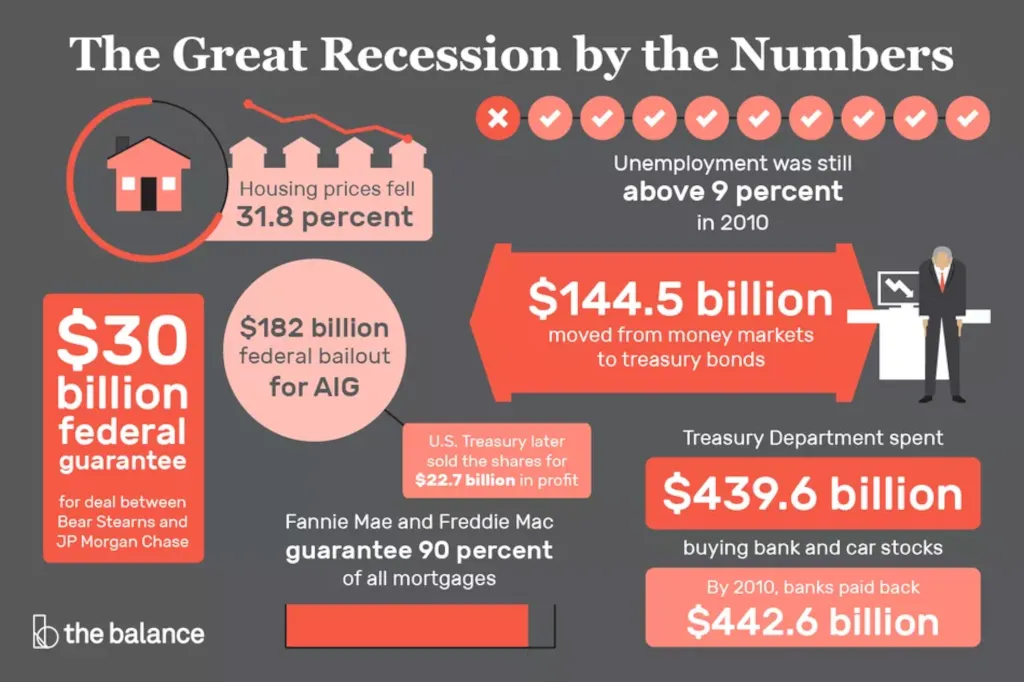
Do I sound cynical enough yet?
Studying this book presents a number of challenges. Since the re-release, tech has brought us Twitter, TikTok, and something. AI is integral to every part of our lives, from healthcare to entertainment to supportive friends. Undoubtedly, the world we live in is not the world Hammer and Champy developed their idea for; the question is: Have businesses outgrown these theories too?
Is reengineering a revolution for the 21st-century corporation or is has it – to quote Hammer’s… interesting… bio “integrated into the DNA” of modern business?
Processes are universal. Everyone everywhere uses a process for everything. We may not always call them processes, think of them as processes, or even think of them at all. But they are, indeed, processes: the “clearing the table process” or the “merging into traffic process.”
Anyone else not run their “responding to email” process in a while?
No? Just me?
Cool.
Cool cool cool.
At Process Street, our raison d’être is locating those “secret” processes, identifying them, and figuring out how to make them work better.
Reengineering – and I’ll go into this more fully later – is, in many ways, about doing the same thing.
“Process understanding […] takes nothing for granted. A reengineering team attempting to understand a process does not accept the existing output as a given. Part of understanding a process is comprehending what the process’ customer does with that output.” – Hammer & Champy, RtC
That belief – understanding how the process works to realize how it could and should work – is the very foundation of everything we do here. We are the xenobiologists of processes.
If it ain’t broke: Reorganizing organizations the Hammer & Champy way
“Reengineering is the fundamental rethinking and radical redesign of business processes to achieve dramatic improvements in critical, contemporary measures of performance, such as cost, quality, service, and speed.” – Hammer & Champy, RtC
Sounds good, right? It hits all those punchy notes affirming the identity stories we’ve manufactured about ourselves as rebels and innovators – not just on the cutting edge, but frickin creating it.
Fundamental. Radical. Dramatic. So exciting.
But what does it actually mean?
You must forgive me, dear reader, because this section will lack my customary wit and entertaining commentary. I want to offer you an objective view of reengineering as a concept so we all start off on the same page.
First, we have to go back in time to the early 20th century. Business organizational models were the new kids on the block, and they were changing the way everything was done. They revolutionized the practice of efficient manufacturing and productivity. Products were manufactured quickly, cheaply, and – most importantly – at a high quality. Technology was advancing in leaps and bounds. And business was very, very good.

The saying goes: if it ain’t broke, don’t fix it, and those early entrepreneurs took that adage to heart. Their models for making cars, trains, planes, and everything else worked and worked well. So they never thought about making changes.
Unfortunately, the world around them not only continued to advance and innovate but did so at an ever-increasing pace. Before long – and certainly by the early ‘90s – that pace completely outstripped the organizational frameworks that had enabled it.
Enter Dr. Michael Hammer, professor, and James Champy, theorist.
The business world, as they perceived it, had become clunky and obsolete. The strategies, structures, and systems used by major corporations were – instead of pushing them forward – holding them back. The world had changed, and they had failed to change with it.
“Ironically, the explanation for why companies perform badly is the identical explanation for why they used to perform so well.” – Hammer & Champy, RtC
For Hammer and Champy, these systems were so fundamentally broken that the only possible solution was to tear down those institutions and rebuild completely anew.
In other words, for Hammer and Champy, it was time to reengineer the corporation.
The brass tacks of business process reengineering
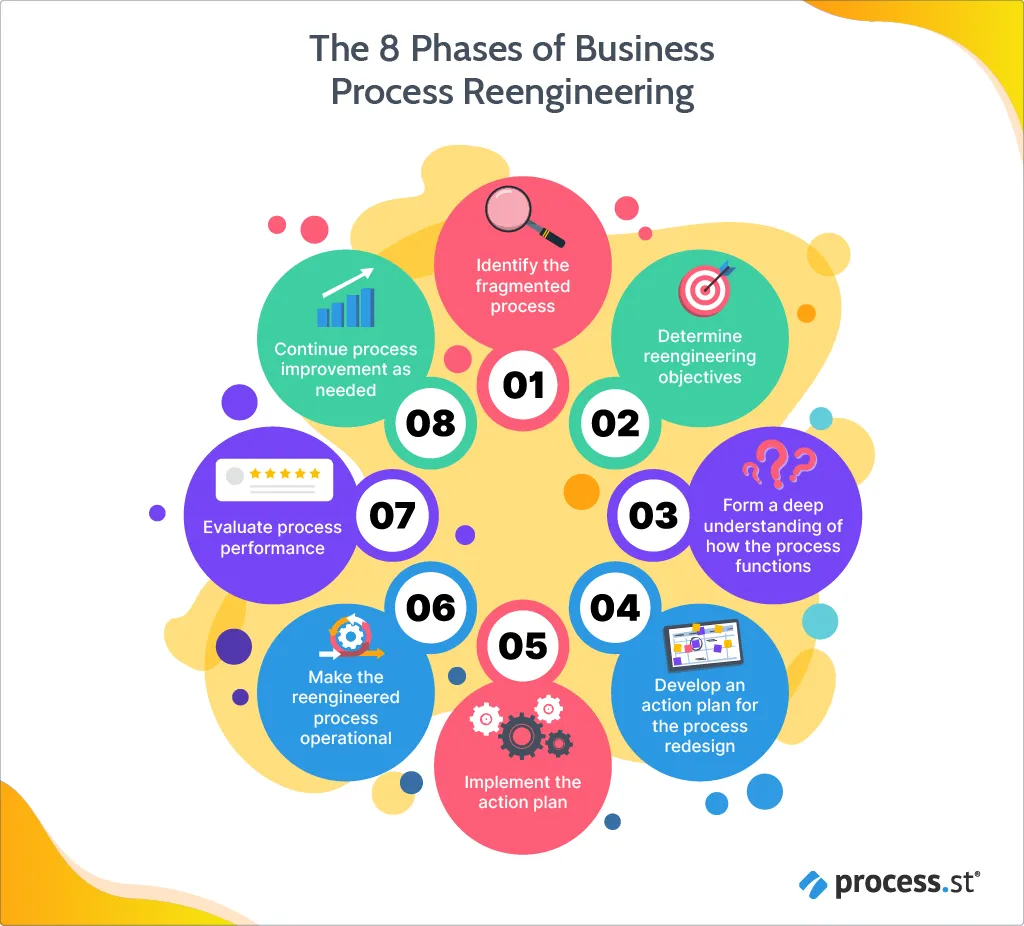
These are what I call the 8 phases of business process reengineering. Together, they make up a fairly general view of what reengineering entails. There isn’t necessarily a distinct separation between every phase, and each phase could easily involve multiple steps or even multiple processes, which is why I’ve opted for “phases” and “cycle” rather than “steps” and “process.” It should give some context and tangibility to what we’re talking about.
Here’s how it all plays out:
Phase 1: Identify the fragmented process: The source of a problem isn’t always immediate, but reengineering the wrong process is very costly, in every way that matters.
Phase 2: Determine the reengineering objectives: Set your OKRs and know your intended outcome. Be specific and clear about what you want to achieve.
Phase 3: Fully understand the process: Understanding is not analysis. Analysis focuses on what a process does; understanding is about how the process is used (and who’s using it).
Phase 4: Develop an action plan: Don’t take it apart unless you know how to put the pieces back together again.
Phase 5: Implement the action plan: Make your changes and test the reengineered process. Then test it again. And again. And again.
Phase 6: Make the reengineered process operational: This is the hard part. You need your people to actively use the reengineered process instead of the fragmented one. Changing processes is a challenge; changing people is like teaching a cat to swim. It’s doable, but it’s certainly not going to be painless for anyone.
Phase 7: Evaluate the process’s performance: Document the results and determine the best course of action. Remember that not all short-term problems need a long-term solution.
Phase 8: Continue to improve as needed: Once you’ve determined whether the issue is an issue and will stay that way long-term, you can look for a solution.
…which brings us right back around to Phase 1.
The who’s who of reengineering
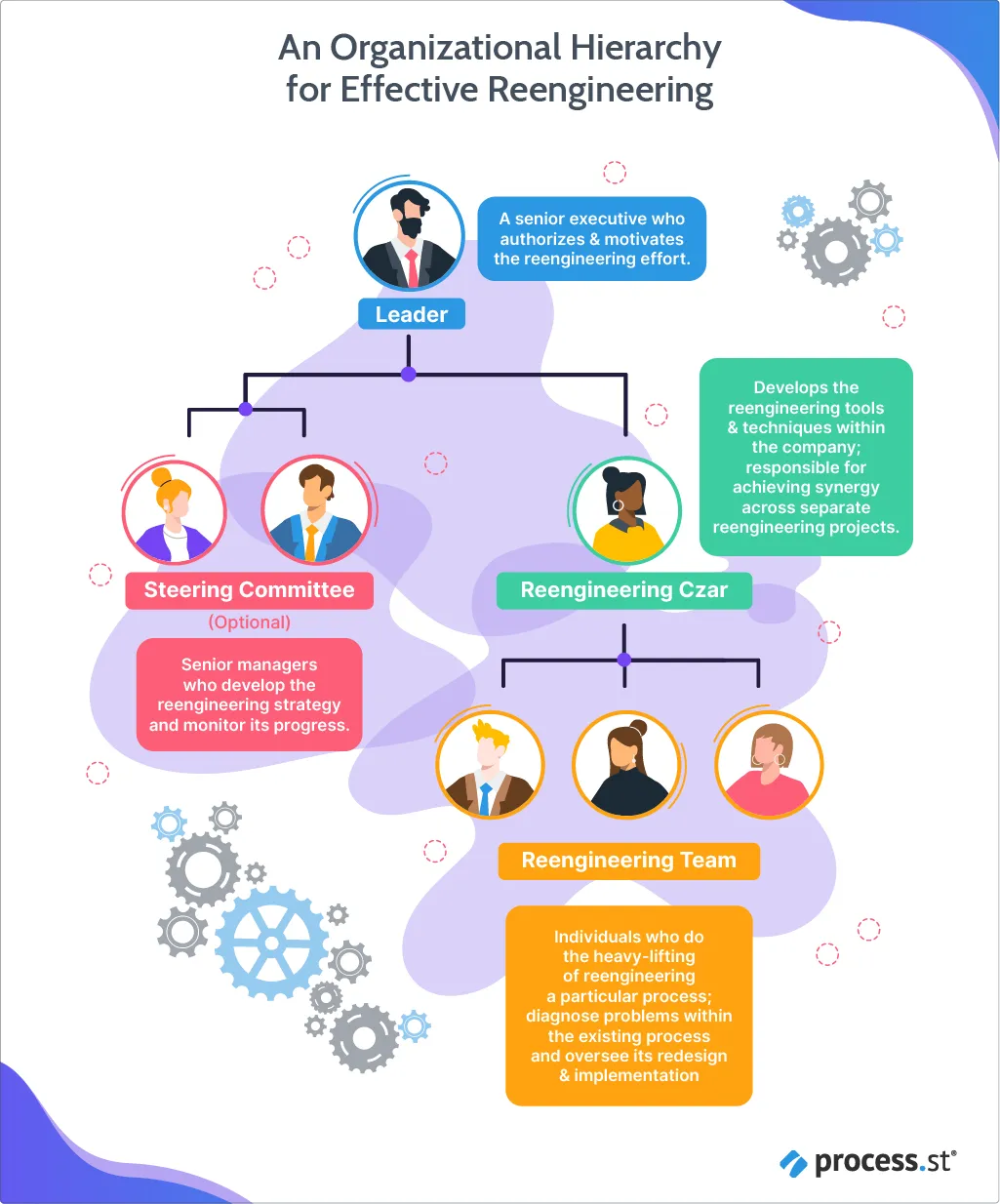 A successful reengineering project is run by a reengineering team. Hammer and Champy stress the importance of including both process “insiders” (those who know and use the process well) and “outsiders” (those outside the process or department, or even the company) to provide input on the process defragmenting.
A successful reengineering project is run by a reengineering team. Hammer and Champy stress the importance of including both process “insiders” (those who know and use the process well) and “outsiders” (those outside the process or department, or even the company) to provide input on the process defragmenting.
There are four main roles to the reengineering hierarchy:
- The Leader: Usually a senior executive with the authority to sway decision-makers, this is the person leading the rallying call for reengineering.
- Reengineering Czar: While the Leader is responsible for hearts and minds, the Reengineering Czar is in charge of nuts and bolts. They drive the practical side of the project.
- Reengineering Team: These are the “insiders” and “outsiders” I mentioned who actually figure out how to redesign the process. It’s probably not a good idea to refer to them as “insiders” and “outsiders,” though.
- (Optional) The Steering Committee: Other senior managers who oversee the reengineering strategy and progress, and work in tandem with the Czar. Usually, decision-makers who have a stake in how it all turns out but don’t have a hands-on role.
Reengineering the Corporation: Benefits & backing
 I’ll be honest: I find Hammer’s style pompous and overblown. Naturally, I had to question whether my resistance to reengineering was really about the concept or the people behind the concept. To answer that question, I went to our COO, Jay Hanlon, who has the benefit of being both quite affable and extremely savvy.
I’ll be honest: I find Hammer’s style pompous and overblown. Naturally, I had to question whether my resistance to reengineering was really about the concept or the people behind the concept. To answer that question, I went to our COO, Jay Hanlon, who has the benefit of being both quite affable and extremely savvy.
“A lot of what they’re getting at – the idea of managers as coaches, having less hierarchy, and more focus on the end-user – is what I like to call ‘servant leadership.’ And I’m a huge buyer of the concept. The main idea is that decisions, trust, and autonomy should be pushed down the organizational chart until it hurts a little.” – Jay Hanlon, Process Street
So, with my negative bias safely tucked away, this is a brief assessment of the potential benefits of taking on reengineering as a project.
First, the book, its anecdotes, and its references are all wildly outdated, even from the 2001 revised edition. The language, too, is definitely meant to push some buttons and stoke some fires. As Professor Brad Jackson observes:
“[Hammer and Champy’s] work was an uncanny evocation of the counter-culture movement of the 1960s. It was chock-full of the language of revolution, urging managers to liberate themselves and become as radical as they can.” – “Hammer, Champy, and reengineering”
I was still wearing Teenage Mutant Ninja Turtle Sneaker Snappers (Raphael, obviously) when Hammer first began shopping his idea around, but let’s think about big business in the early ‘90s.
Large corporations were clunky, slow, and well out of touch with consumers and the world they lived in. They operated on a framework that assumed only senior leadership could make decisions and departments operated on a fairly rigid structure of duties and responsibilities.
At the time, in that environment, the only way to bring substantial change to the system was to break the system. And that is the point Hammer and Champy were trying to make with reengineering:
The organizational frameworks of large corporations were so inherently flawed that attempting any sort of “fix” would only create more flaws, more inefficiencies, and more bottlenecks. The system that had been built around Adam Smith’s ubiquitous pin factory hadn’t moved forward in over two centuries.
To correct that level of stagnation required something… Well, something a little dramatic and radical.
Maybe even to do with processes.
IBM
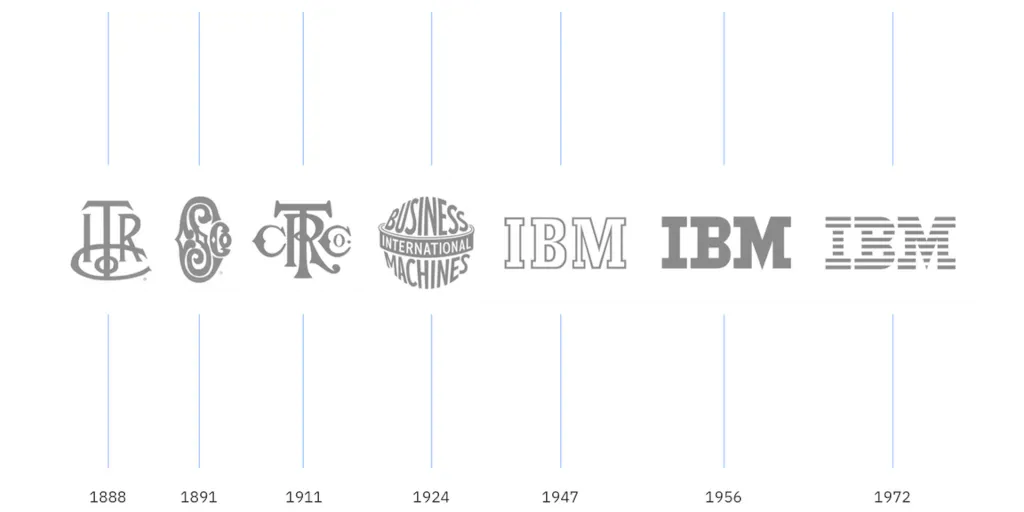
IBM is such a fan of reengineering that after using it on their own subsidiary, IBM now offers consultancy services to help other businesses reengineer their processes.
IBM Credit Corporation’s financing process was, to put it kindly, useless. Bare minimum, in an ideal scenario, from start to finish, it took 6 days to process a financing request. In the real world, it often ended up lasting 2 weeks.
This was not good for the salesperson. The average IBM cost around $3000 in 1990 (that would be over $6000 today). Even 6 days is a long time to consider whether you really want to drop that much cash on a funky-looking magic box.
After a few false starts and several frustrated sales reps, a couple of senior managers decided to walk a financing request through each step of the process to see exactly how long the process took if all delays were factored out.
90 minutes later, the request had been completely processed and decided. The bulk of that 6-day turnaround in the process was all handoffs; on average, one financing request was handled by 8 different people, not including the sales rep.
The solution?
IBM replaced their financing specialists with generalists who had the necessary skills to handle an average financing request. One person, the deal structurer, completed the entire process so there were no more handoffs. For complicated cases, the deal structurer could reach out to an expert, but IBM no longer needed a team of experts to review every request.
As a result:
- Turnaround was cut down to 4 hours (a 90% reduction);
- The number of deals handled increased 100 times what it had been;
- A “small head-count reduction” was achieved.
(Remember, though, the goal of reengineering isn’t downsizing. That’s just a perk.  )
)
Reengineering the Corporation: Criticisms & consequences
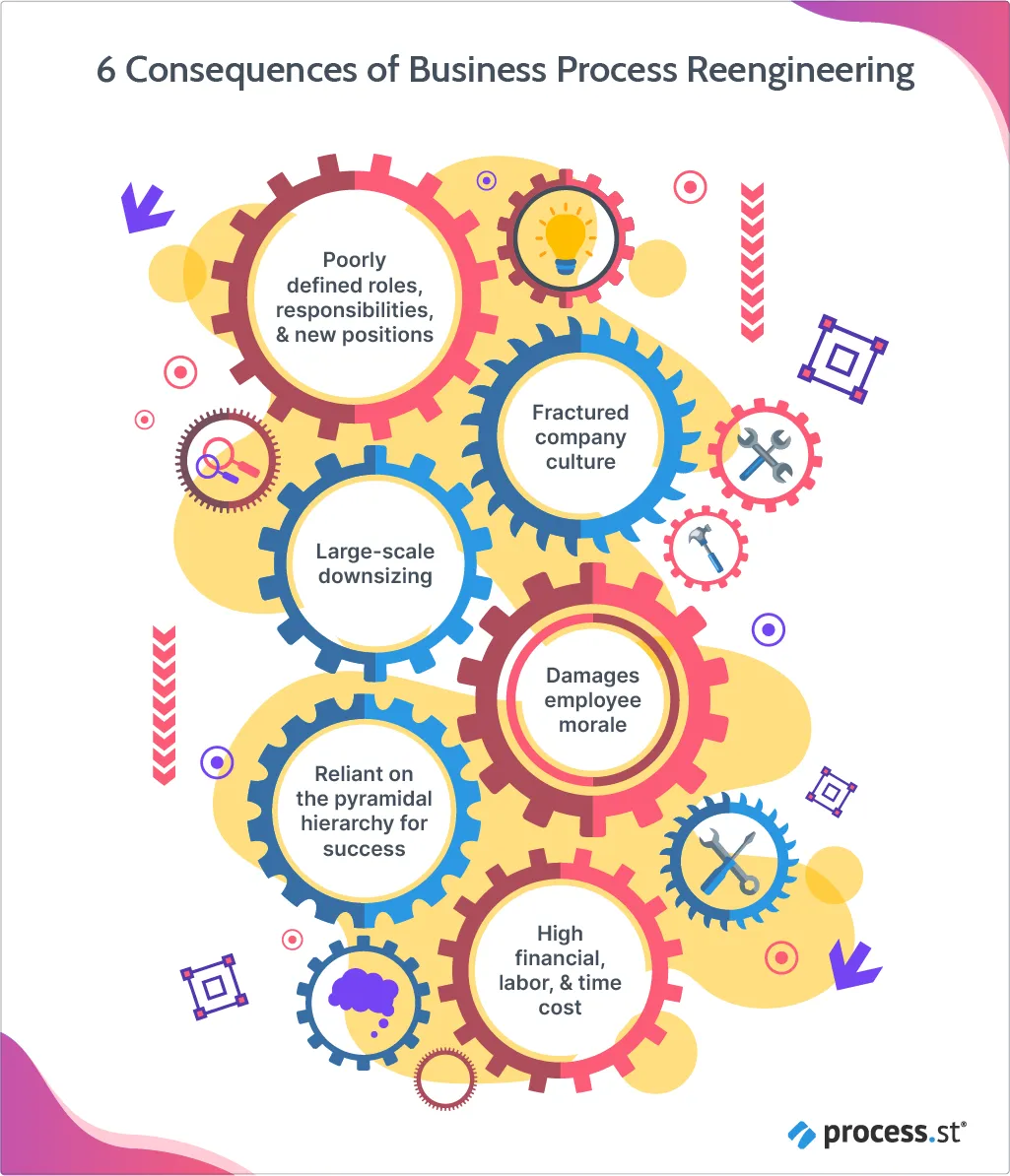 The concept of reengineering has one crucial, monumental, and undeniable flaw: The people expected to drive the process of reengineering – middle management – generally won’t have a job at the end of the process.
The concept of reengineering has one crucial, monumental, and undeniable flaw: The people expected to drive the process of reengineering – middle management – generally won’t have a job at the end of the process.
Obviously, this gives them little motivation to support and facilitate a successful reengineering project. For our middle managers, this creates a paradox:
- They support reengineering, which threatens their existence within the organization.
- They oppose reengineering, which eliminates survival within the organization post-reengineering.
As a result, even if the reengineering effort itself is successful in achieving its initial purpose, there are often long-term costs and consequences that bring that success into question.
In his chapter on reengineering, Brad Jackson provides an excellent first-hand account of this exact situation playing out:
The Faculty of Continuing Education, University of Calgary

For three years, the Faculty of Continuing Education had been operating under a financial deficit.
By anyone’s measure, this was a problem.
Jackson, along with a number of his colleagues, were intrigued by the concept of reengineering. It seemed to offer the promise of solving their financial problems and breaking down institutional barriers they felt were holding them back.
“The sense of excitement, risk, and adventure that accompanies reengineering is a tempting combination for individuals like myself, who tend to be frustrated with inaction and want to make something happen immediately within their organization.” – Prof. Brad Jackson, Management Gurus and Management Fashions
In the case of Jackson’s department, the financial difficulties were solved by reengineering how the faculty worked. Immediately following the project, the faculty actually generated revenue and is widely recognized as operating more efficiently and effectively than prior to reengineering.
This improvement came with a hefty price, however. The extent of hostility and fractured relationships between faculty members was so extensive that even more than four years later, those relationships hadn’t been repaired. Overall morale during the reengineering project plummeted and those driving the change found their own reputations following suit.
Through reengineering, the Faculty of Continuing Education solved their financial problem and created a people problem.
Can today’s COO still learn from Reengineering the Corporation?
The TL;DR of it all is: Probably not. But wait –
Is the book worth reading? Not really.
Have Hammer and Champy won me over? Definitely not.
Should you understand the principles involved in reengineering? Absolutely.
Let me explain.
Hand to heart, I am a strong supporter of the break-it-to-remake-it ideology.
Midway through my Ph.D. with over half of my thesis written, I scrapped it all and started over. My supervisors, my peers, even random acquaintances who had no real concept of what my research actually involved all thought I was insane to throw out what amounted to – at the time – about 60,000 words and 4 years of intense effort.
The thing is: That thesis wasn’t working. Every tweak and small alteration I made only increased how much it wasn’t working. There were simply too many flaws to fix and fix well.
Now, don’t get me wrong: This was not an easy move. I had regrets and many weak moments where I was tempted to resurrect the old because I wasn’t certain what the new would look like. In the end, the thesis I submitted was substantially better than the thesis I threw out.
Even now, if a setup isn’t working or a draft isn’t going anywhere, I always opt for a blank slate. Sometimes it just works.

But should you approach your business the same way?
If you strip away the buzzwords and salespeak, reengineering comes down to a very basic concept: continuous process improvement.
Continuous process improvement is not radical, dramatic, or about throwing it all in the bin. It’s incremental, it’s intentional, and it’s integrated into your daily workflows.
Say you run a workflow today that you ran yesterday and the day before, etc. Only this morning your line manager pinged your team’s Slack channel to say the company is moving from Policy A to Policy B. Step two in the workflow revolves entirely around Policy A.
Startups move fast. The status quo in the morning may not be the status quo by end-of-day. Corporations have also realized that if they want to compete, they need to stay just as quick and agile. Businesses simply can’t afford to blow up their framework for 12+ months just because they want to shake things up a little.
“Now, if you already have a company with lots of autonomy, trust, and effective cross-departmental collaboration, then massive, non-iterative change is not only isn’t necessary, it’s a dangerous risk. But, on the other hand, if you’re trying to compete with startups, but run your organization like a bank from the ‘90s, you’d better be willing to make massive changes or you’ll cede the future to companies that are more nimble and better utilize their talent at all levels.” – Jay Hanlon, Process Street
The principle of reengineering that’s still very, very relevant for today’s organization – whatever that organization may be – is that you need to trust your people.
You need to give them autonomy and empower them to make decisions and changes to the processes that they use every day. Your employees know the ins and outs of their own processes much better than you do, so give them the room to really make those processes work the best they can.
Even the old-school, massive overhaul reengineering required the support and participation of the people who know the existing processes best. You might as well get those people making iterative changes to your processes now, and save yourself a lot of time and resources down the road.
I’d like to finish with a quote from Hammer on process-centered organizations, because it’s both apt and true:
“The process-centered organization is characterized by responsibility, autonomy, risk, and uncertainty. It may not be a gentle environment, but it is a very human one. Gone are the artificial rigidities of the conventional corporation. In its place is a world full of messiness, challenges, and disappointments, that characterize the real world of real human beings.” – Beyond Reengineering, 1996
Was reengineering just a fad? Is it still imminently valuable? Let’s discuss it in the comments!
The post Blog first appeared on Process Street | Checklist, Workflow and SOP Software.
